This article needs additional citations for verification .(July 2021) |

Publius Ostorius Scapula (died 52) was a Roman statesman and general who governed Britain from 47 until his death, and was responsible for the defeat and capture of Caratacus.
This article needs additional citations for verification .(July 2021) |

Publius Ostorius Scapula (died 52) was a Roman statesman and general who governed Britain from 47 until his death, and was responsible for the defeat and capture of Caratacus.
Publius Ostorius Scapula was the son of a Publius and likely the nephew of Quintus Ostorius Scapula, the first joint commander of the Praetorian Guard appointed by Augustus and later prefect of Egypt. The Quintus Ostorius Scapula who was consul in 41 AD was probably his brother or cousin.
Nothing is known of his early career. He was suffect consul, probably in 46. In the winter of 47 he was appointed the second governor of Roman Britain by the emperor Claudius, succeeding Aulus Plautius. The south and east of the island was securely occupied and alliances had been made with tribes outside the Roman-controlled area, but other tribes continued to resist. Believing a new governor would be reluctant to campaign so late in the year, they staged attacks and uprisings.
Ostorius disabused them of this notion and responded vigorously, attacking relentlessly and allowing the native resistance no time to regroup. He apparently (based on an emendation of a corrupt passage in Tacitus's Annals ) declared his intention to disarm all the Britons south and east of the rivers Trent and Severn. The geographical area described has led to discussion about the role of the Fosse Way as a desired frontier line during the period, as it links the Trent and the Severn.
The Iceni, a tribe based in Norfolk who had not been conquered but allied themselves with the Romans voluntarily, objected to this plan and led neighbouring tribes in an uprising. Ostorius defeated them by storming a hill fort, possibly Stonea Camp in the Fens near March in Cambridgeshire, in a hard-fought battle. His son, Marcus Ostorius Scapula, won the corona civica for saving a Roman citizen's life during the fighting. The Iceni remained independent, and it is likely that Prasutagus was installed as a pro-Roman ruler at this time.
After putting down the rebellion he began expeditions beyond the frontier, beginning with a productive campaign against the Deceangli tribe in north Wales and the Cheshire Gap in 48. This was an astute move as it divided the tribes of North Britain from those in Wales. He was recalled east however after a new rebellion by a faction of the Brigantes. This was quickly suppressed but revealed the dangers in the Romans' client kingdom system of which the Brigantes were a part; troops from the Legio XIV Gemina were stationed in the area to keep the Brigantian peace. At this time the Legio II Augusta held the command in the south east, the Legio IX Hispana was campaigning the north east beyond the Trent, the Legio XX Valeria Victrix held Colchester and the Legio XIV was based at Wroxeter.
Ostorius initiated further Romanisation during his command in the safer southern lands, founding Britain's first colony of military veterans at Camulodunum (modern Colchester) in 49 and probably establishing a municipium at Verulamium (St Albans). His tactical skill rather than his political acumen was his strength however. He had received a difficult brief as the Claudian lowlands were economically unspectacular and Britain's mineral wealth lay in the barbarian lands instead. Capture of these would have to wait until later years.
In the meantime, Caratacus, whose tribe, the Catuvellauni, had been defeated in the first phase of the conquest, had re-emerged as a leader of the Silures of south east Wales and Gloucestershire. Their rising was controlled by a programme of legionary fortress construction, driving Caratacus north into the lands of the Ordovices. Ostorius managed to force him into an open conflict, after several years of guerrilla war. They fought a battle, probably near the River Severn and possibly near Caersws, where the Romans defeated the British leader in 51.
The Ordovices had fortified a ridge of steep hills above the river and the difficulty of the terrain behind them made an encircling manoeuvre by the Romans impossible. Although Ostorius was concerned at the seemingly impregnable defences, Tacitus records that the eagerness and loyalty of his troops persuaded him to attack and in the end the Britons were easily defeated. Caratacus' wife and daughter were captured and his brother surrendered while Caratacus himself fled to the territory of the Brigantes. However their queen, Cartimandua, was loyal to Rome and handed him over in chains.
After the battle, Ostorius was honoured with triumphal insignia but the victory did not entirely quell resistance in the Welsh borders. The Silures especially continued to harass Roman troops, supposedly after Ostorius had publicly said that they posed such a danger that they should be either exterminated or transplanted. A large legionary force occupied in building forts in Silurian territory was surrounded and attacked and only rescued with difficulty and considerable loss. This violent desperation on the part of the Silures can be attributed to their reaction to what Peter Salway calls Ostorius' lack of political judgment. The Silures had been galvanised by Ostorius' ill-thought out threats to destroy them and began taking Roman prisoners as hostages and distributing them amongst their neighbouring tribes. This had the effect of binding them all together and creating a new resistance movement.
Ostorius died unexpectedly in 52, supposedly "worn out with care" as Tacitus puts it, leaving Rome with a growing problem on its British frontiers. It has been claimed that his final resting place is in Clawdd Coch in the Vale of Glamorgan, southeast Wales. [1] Silurian raids continued, defeating a legion led by Gaius Manlius Valens, before Aulus Didius Gallus arrived as replacement governor. The complete pacification of the area was achieved only 25 years later by Sextus Julius Frontinus.
A Sallustia Calvina is attested as the wife of a Publius Ostorius Scapula, possibly the governor or his father, if the wife of the governor she might have been the daughter of Gaius Sallustius Passienus Crispus and Junia Calvina. [2]
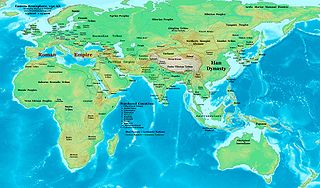
The 50s decade ran from January 1, 50, to December 31, 59. It was the sixth decade in the Anno Domini/Common Era, if the nine-year period from 1 AD to 9 AD is considered as a "decade".
AD 48 (XLVIII) was a leap year starting on Monday of the Julian calendar. At the time, it was known as the Year of the Consulship of Vitellius and Poplicola. The denomination AD 48 for this year has been used since the early medieval period, when the Anno Domini calendar era became the prevalent method in Europe for naming years.
AD 51 (LI) was a common year starting on Friday of the Julian calendar. At the time, it was known as the Year of the Consulship of Caesar and Scipio. The denomination AD 51 for this year has been used since the early medieval period, when the Anno Domini calendar era became the prevalent method in Europe for naming years.

The Roman conquest of Britain was the conquest of the island of Britain by occupying Roman forces. It began in earnest in AD 43 under Emperor Claudius, and was largely completed in the southern half of Britain by 87 when the Stanegate was established. Attempts to conquer Scotland in succeeding centuries met with little sustained success.
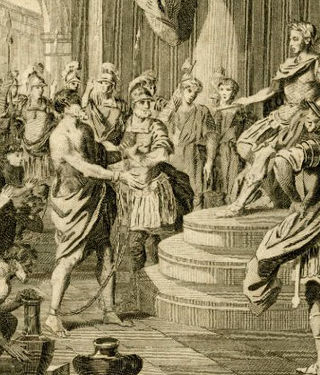
Caratacus was a 1st-century AD British chieftain of the Catuvellauni tribe, who resisted the Roman conquest of Britain.
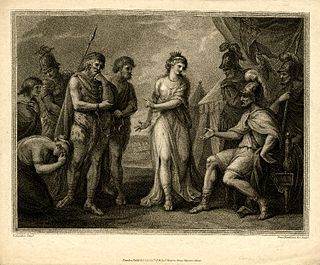
Cartimandua or Cartismandua was a 1st-century queen of the Brigantes, a Celtic people living in what is now northern England. She came to power around the time of the Roman conquest of Britain, and formed a large tribal agglomeration that became loyal to Rome. The only account of her is by the Roman historian Tacitus, through which she appears to have been widely influential in early Roman Britain.
The Silures were a powerful and warlike tribe or tribal confederation of ancient Britain, occupying what is now south east Wales and perhaps some adjoining areas. They were bordered to the north by the Ordovices; to the east by the Dobunni; and to the west by the Demetae.
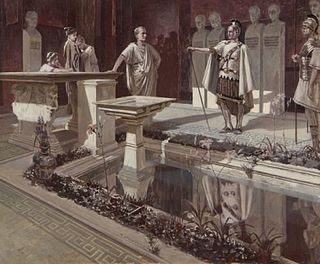
Aulus Plautius was a Roman politician and general of the mid-1st century. He began the Roman conquest of Britain in 43, and became the first governor of the new province, serving from 43 to 46 CE.

Venutius was a 1st-century king of the Brigantes in northern Britain at the time of the Roman conquest. Some have suggested he may have belonged to the Carvetii, a tribe that probably formed part of the Brigantes confederation.
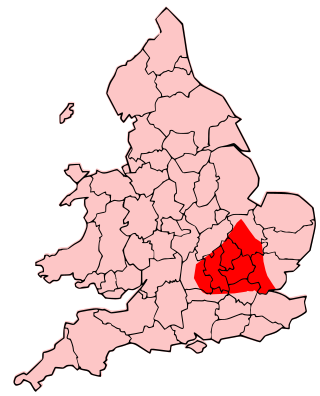
The Catuvellauni were a Celtic tribe or state of southeastern Britain before the Roman conquest, attested by inscriptions into the 4th century.

The Ordovīcēs were one of the Celtic tribes living in Great Britain before the Roman invasion. Their tribal lands were located in present-day North Wales and England, between the Silures to the south and the Deceangli to the north-east. Unlike the latter tribes that appear to have acquiesced to Roman rule with little resistance, the Ordovices fiercely resisted the Romans. They were eventually subjugated by the Roman governor Gnaeus Julius Agricola in the campaign of 77–78CE when the Romans overran their final strongholds on Anglesey.

The Brigantes were Ancient Britons who in pre-Roman times controlled the largest section of what would become Northern England. Their territory, often referred to as Brigantia, was centred in what was later known as Yorkshire. The Greek geographer Ptolemy named the Brigantes as a people in Ireland also, where they could be found around what is now Wexford, Kilkenny and Waterford, while another people named Brigantii is mentioned by Strabo as a sub-tribe of the Vindelici in the region of the Alps.
Junia Calvina was a Roman noblewoman who lived in the 1st century AD.
Aulus Didius Gallus was a member of the Roman Senate and general active during the 1st century AD. He held a number of offices and imperial appointments, the most important of which were governor of Britain between 52 and 57 AD, proconsul of Asia, and suffect consul in the nundinium of September to December 39 as the colleague of Domitius Afer.
The final battle in Caratacus's resistance to Roman rule was fought in 50 AD. The Romans under Publius Ostorius Scapula defeated the Britons and in the aftermath captured Caratacus himself, since 43 the leader of armed opposition to the Roman conquest of Britain. He was paraded through Rome and given the opportunity to make a speech before the emperor Claudius, who spared his life and those of his family and retainers.
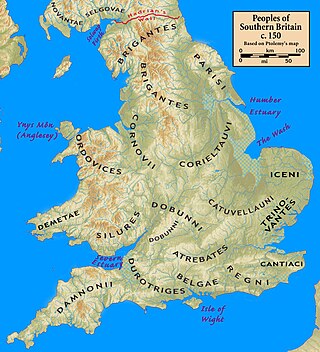
The Roman client kingdoms in Britain were native tribes which chose to align themselves with the Roman Empire because they saw it as the best option for self-preservation or for protection from other hostile tribes. Alternatively, the Romans created some client kingdoms when they felt influence without direct rule was desirable. Client kingdoms were ruled by client kings. In Latin these kings were referred to as rex sociusque et amicus, which translates to "king, ally, and friend". The type of relationships between client kingdoms and Rome was reliant on the individual circumstances in each kingdom.
Events from the 1st century in Roman Britain.
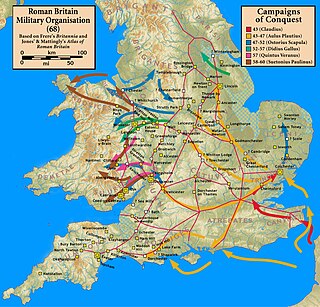
Strutt's Park Roman Fort was a Roman fort in Strutt's Park, a suburb of Derby in Derbyshire, England. It was built around the year 50 and replaced, probably between the years 75 and 80, by a new fort at Little Chester on the opposite bank of the River Derwent.
The gens Ostoria, occasionally written Hostoria, was a plebeian family at Rome. Members of this gens are first mentioned in the early years of the Empire. Although only a few of them achieved any prominence in the Roman state, many others are known from inscriptions. The most illustrious of the Ostorii was probably Publius Ostorius Scapula, who was consul during the reign of Claudius, and afterward governor of Britain.
Gaius Manlius Valens was a Roman senator of the late first century AD. He was selected as consul ordinarius in his ninetieth year, serving with Gaius Antistius Vetus in AD 96.